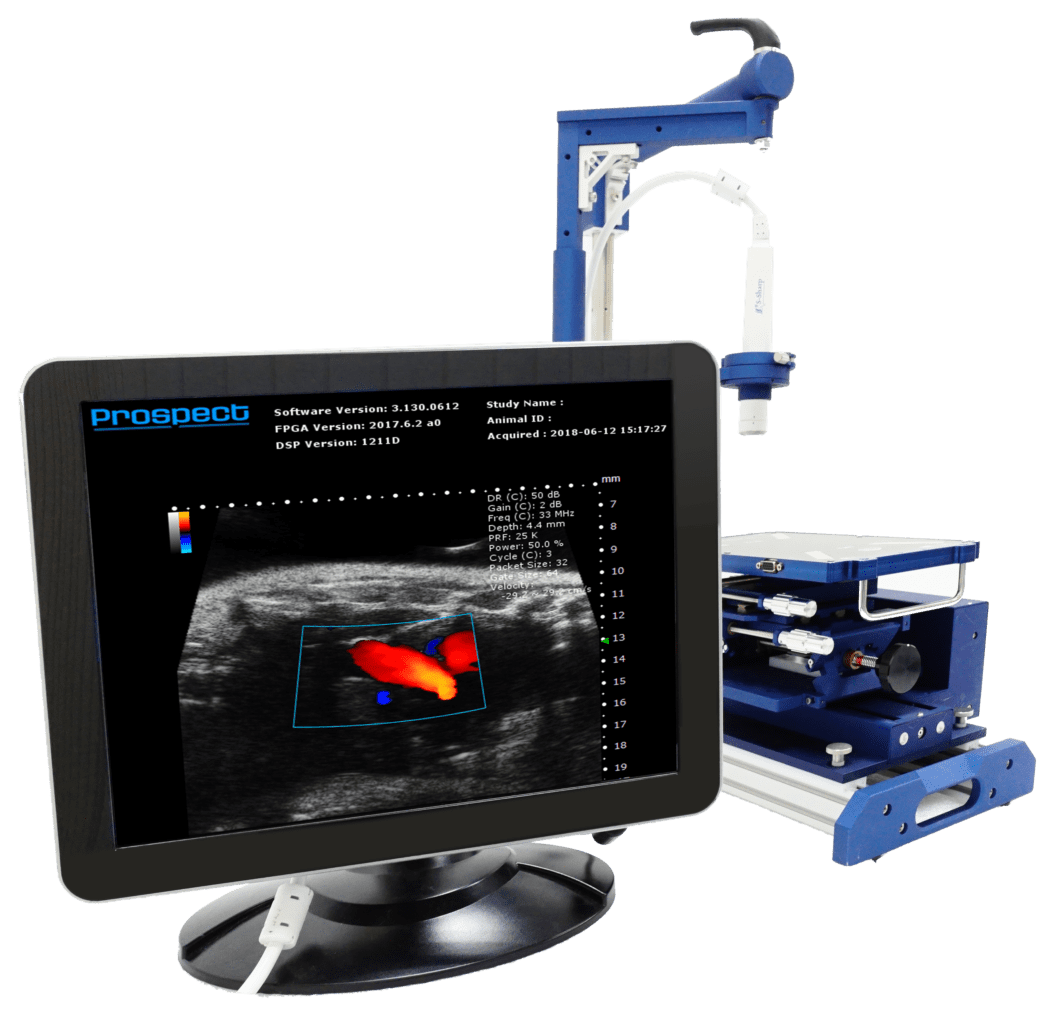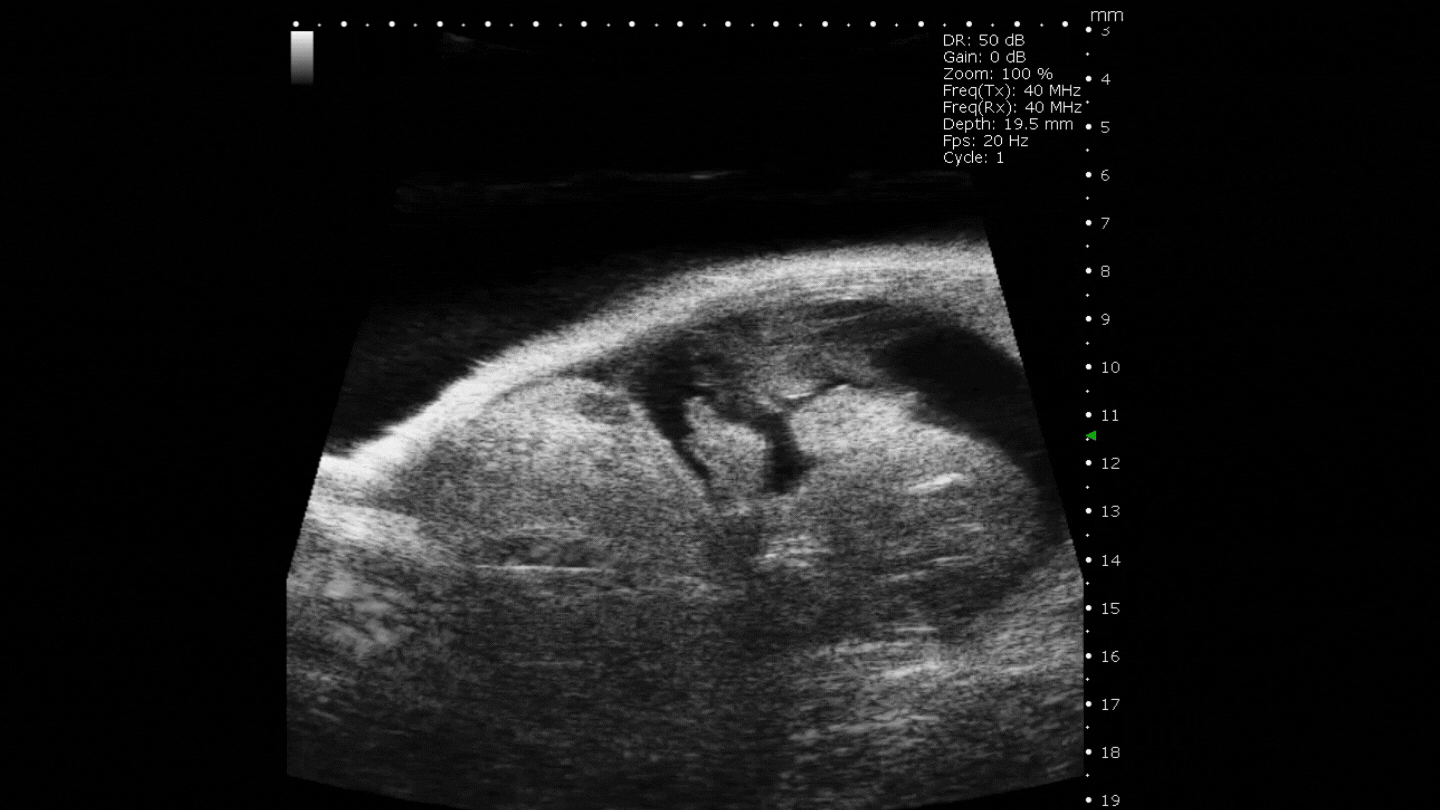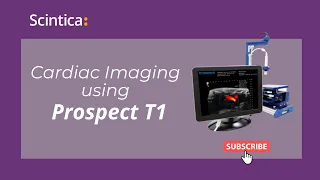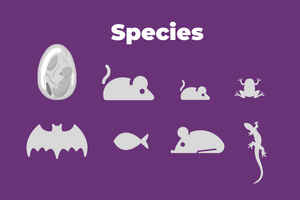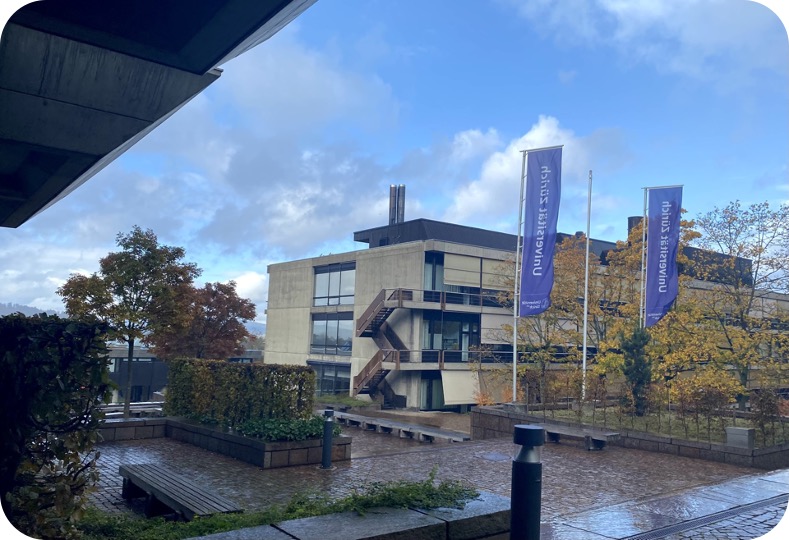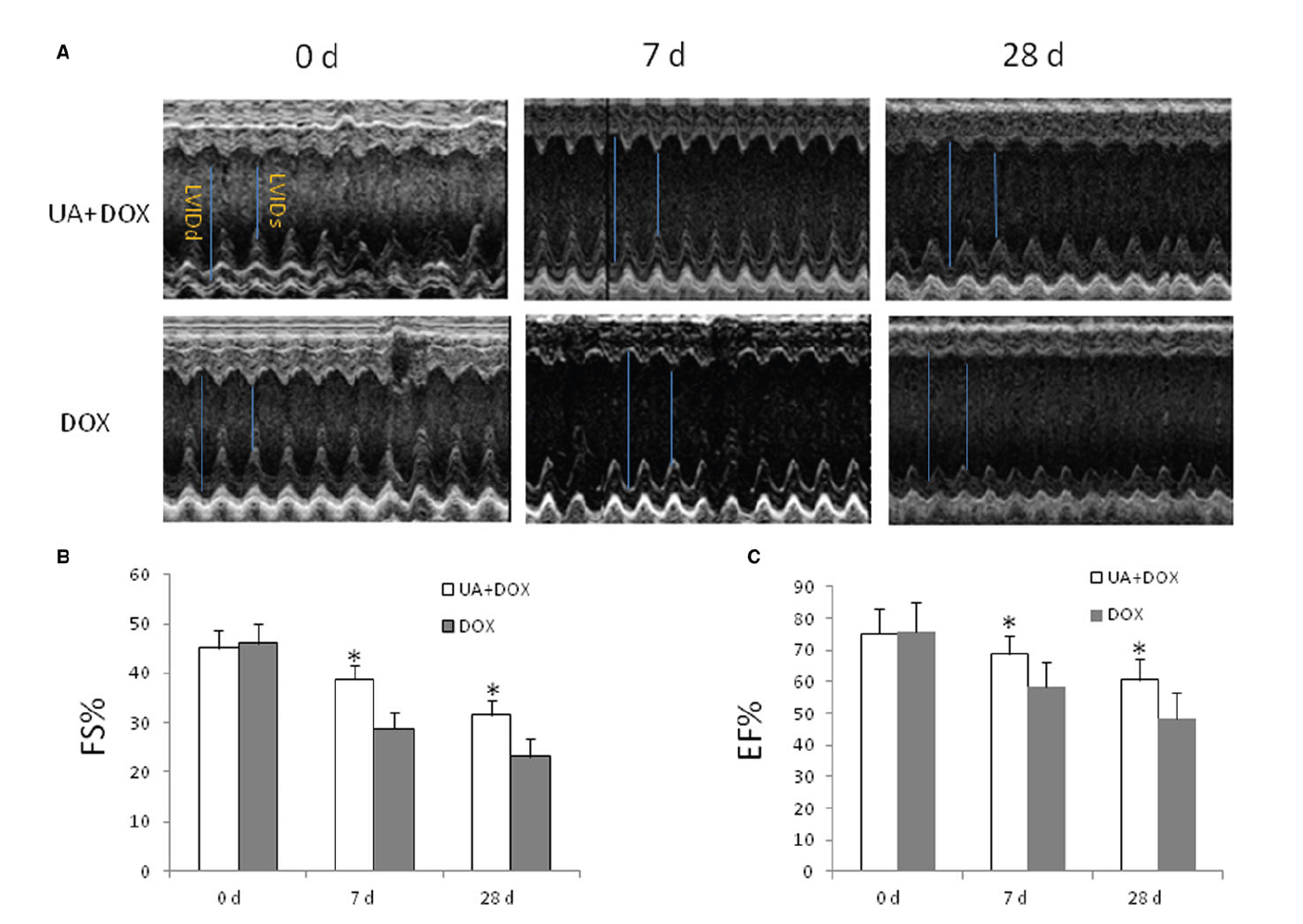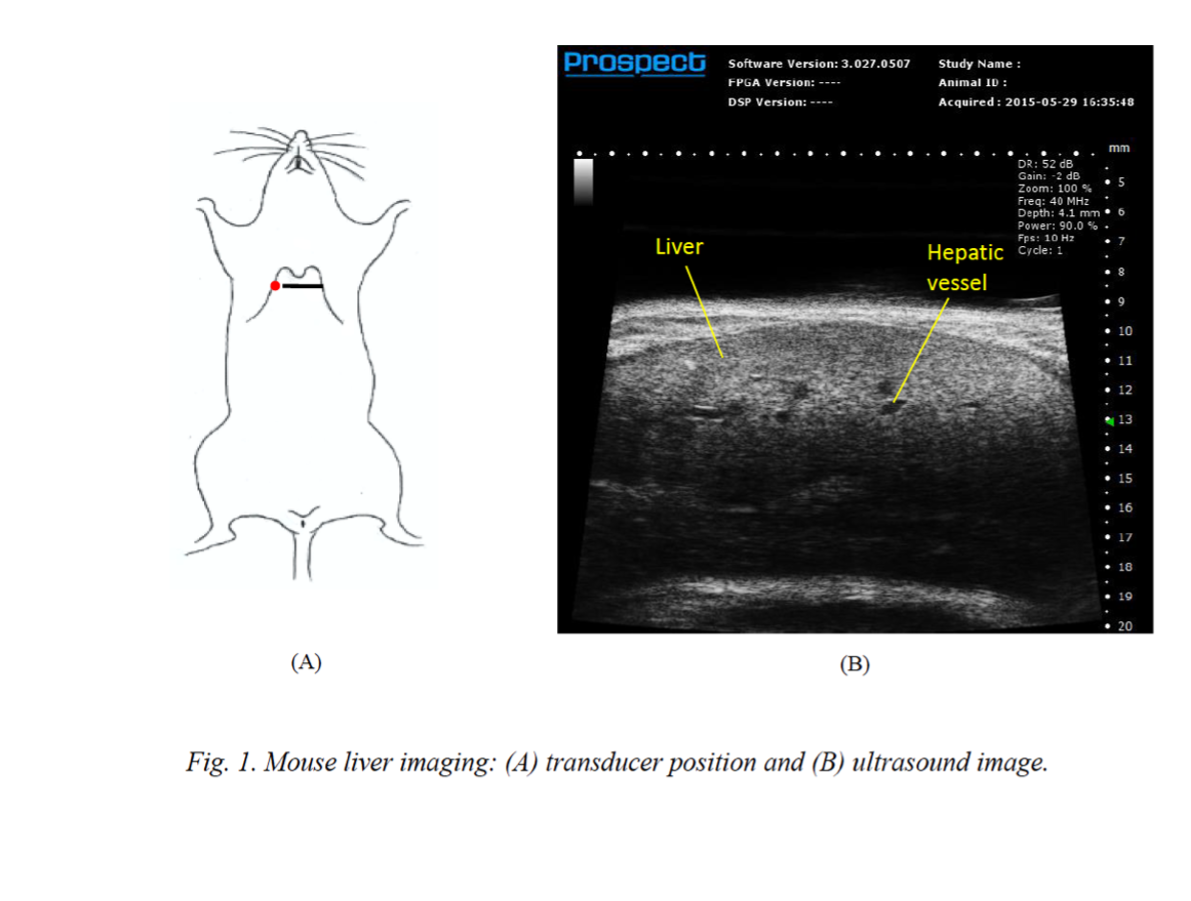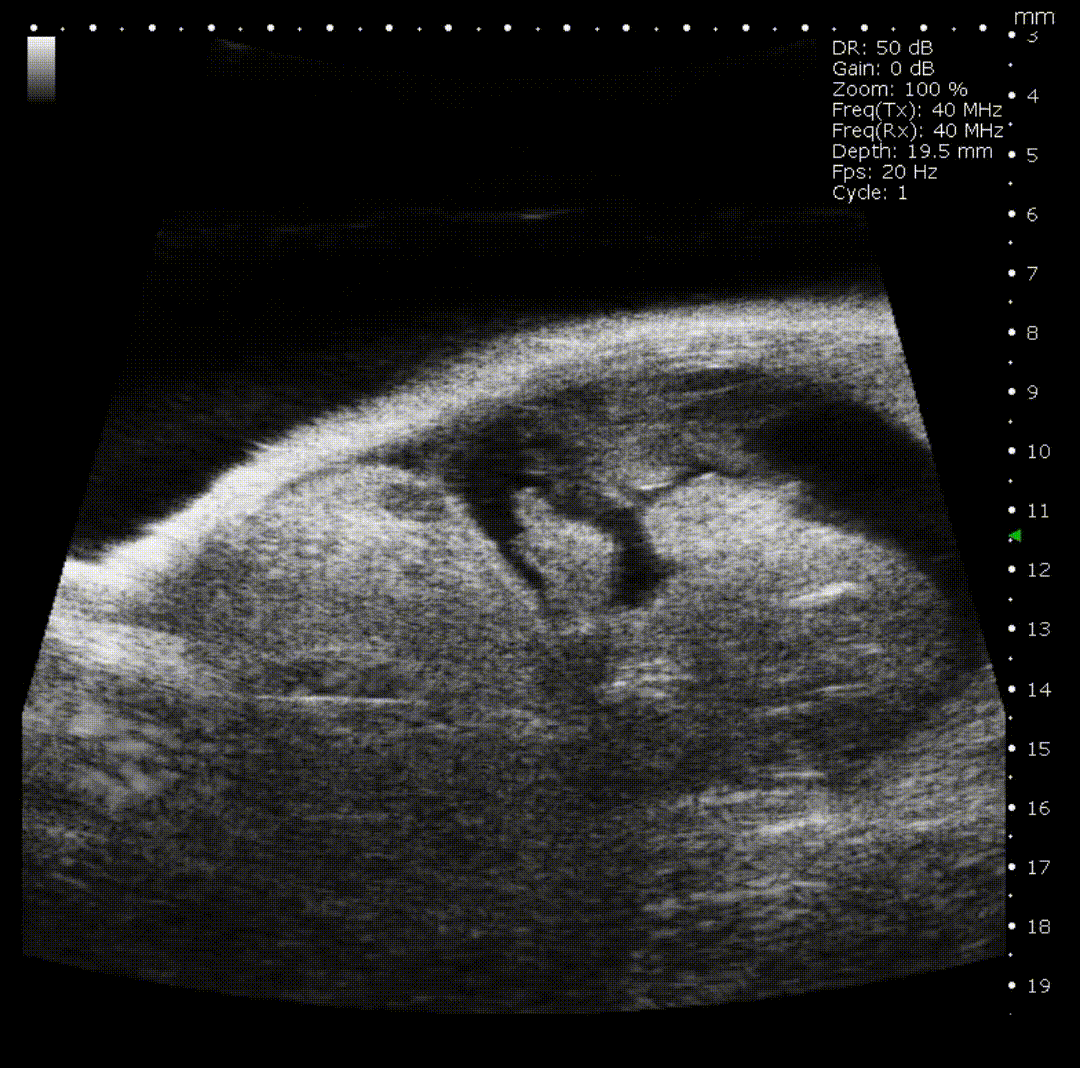System Overview
The Prospect T1 has been specifically designed for preclinical imaging of small animals including mice and rats. These species require very high-resolution images (up to 30µm) to observe anatomical structures, and considerations to monitor changes in hemodynamics due to their high heart rates. This tablet based, high frequency, compact ultrasound system is a cost-effective alternative to other preclinical ultrasound systems on the market, allowing individual labs to harness the power of this real-time imaging modality.
The system is well equipped with standard ultrasound capabilities including B-mode, EKV mode, M-mode, Color and Power Doppler, Pulsed Wave Doppler, Tissue Doppler, and Contrast imaging (reference subtracted and harmonic options are available). In all modes, the RAW digital RF data can be saved for further analysis should this be desirable. Additionally, the system’s capabilities may be expanded to acquire 3D B-mode images, perform image guided injection, or to perform shear wave elastography.
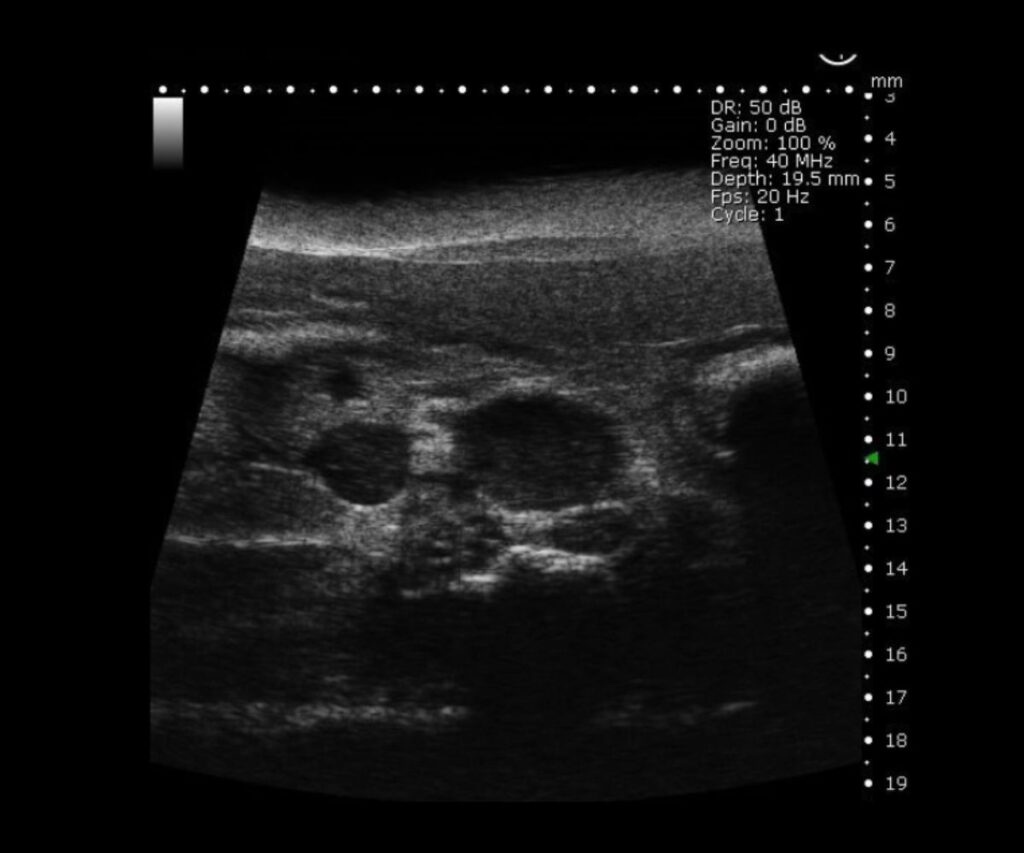
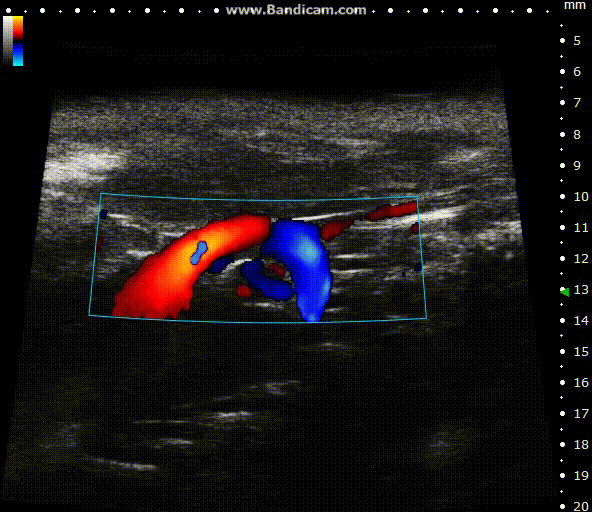
The standard configuration and capabilities of the Prospect T1 allow for researchers with a wide variety of research interests to utilize the system; these applications include cardiovascular research, cancer biology, general abdominal/anatomical imaging, developmental biology, as well as ophthalmology applications.
The suite of analytical tools and measurement packages allow imagers to quickly generate quantitative results over the course of their longitudinal studies.Included with the system is the scanning platform which may be equipped with either a heated mouse or rat sized platform, which has integrated physiological monitoring. This animal handling apparatus has been ergonomically designed to allow for easy positioning of the ultrasound probe to acquire the desired images, while being easy to clean as needed between imaging subjects.
Currently there are three different single element probes available, the choice of which to use is dependent on the animal to be imaged and the anatomical targets, center frequencies range from 20-50MHz, with broadband frequencies up to 60MHz.
Offline data analysis is also available to ensure that the system time is reserved for image acquisition, while data can be transferred to an analysis station to perform measurements as needed. Images may be exported in standard formats, while data may be compiled into reports and exported into .csv files for compilation and statistical analysis.
Features & Benefits
The Prospect T1 is a cost effective high-frequency preclinical ultrasound system for mice, rats and other small animals, optimized to study the hemodynamics and vascular function at the laboratory benchtop instead of from inside a core imaging facility.
Standard Imaging Modes
- B-Mode
- M-Mode
- Pulsed Wave, Tissue, Color, Power Doppler
- Contrast Mode – linear and non-linear/harmonic
The standard system can be used by a wide variety of researchers, studying various disease models including cardiovascular disease, cancer research, developmental biology, etc. Movement of the excitation source over the entire FOV ensures consistent and reproducible results over the course of a longitudinal study.
System may be configured with up to 3 different probes:
- 20MHz
- 40MHz
- 50MHz
System has 2 available animal platforms:
- Mouse table
- Rat table
Available optional probes and animal platforms allow the systems to be configured to meet a specific research team’s need.
Additional probes and platforms may be added in the future to expand capabilities as needed.
.
ECG Gated Kilohertz Visualization (EKV) mode available on all systems
This mode allows users to acquire B-mode images of the heart with up to 400fps; these images provide exquisite detail of cardiac motion and may be used with any of the standard measurement tools.
RAW data, and corresponding import scripts are available in all modes.
Researchers who would like to look at the digital RF data from any mode can easily access the data off the system and import into third party software for further analysis.
System includes a tablet-based acquisition computer with compact scanning platform
Small system footprint which requires less space than conventional systems.
The system may be easily moved and does not need to reside in a core facility.
The system can fit within a biosafety cabinet if needed, to help researchers who may be working with immunocompromised animals, or those with other concerns.
Simplified image guided injection mount
With the probe and injection mount connected, once the needle and imaging plane are aligned, the user can move the probe/needle as needed to perform the injection.
Comprehensive measurement package is included on the system, with available optional offline analysis software license
Users can quickly perform the measurements they desire, compile data reports, and generate quantifiable outputs from images and spectrograms.
This analysis may be done on the system, or at an offline analysis workstation.
Add-on hardware/software options are available:
- 3D Motor including software for volume measurements
- Image Guided Injection Mount, with software image guide
- Shear Wave Elastography/ Acoustic Radiation Force push probe and software integration
These optional components are available to those researchers who have specific needs.
They are not included in all systems to keep costs as low as possible but can be easily added to any system when needed.
System has been designed with an intuitive workflow with touch screen user interface (keyboard and mouse also come with the system)
Preclinical researchers can quickly start their studies, acquire and store images from the various modes available, and quickly review their data and perform their required measurements.
Non-linear (first harmonic) contrast agent imaging is available using both the 20MHz and 40MHz probes
This allows for increased sensitivity to microbubble contrast agents, without the need for reference subtraction that is required for linear contrast agent imaging.
This improves signal sensitivity, and risk of motion artefact within the images.
Imaging Modes
B-Mode
B-Mode
Mouse Left Ventricle in Long Axis – B-Mode
B-Mode
B-Mode
Mouse Carotid Artery – B-Mode
B-Mode
B-Mode
Mouse E15 Embryo – B-Mode
3D B-Mode
Mouse Mammary Fat Pad Tumor – 3D B-Mode
ECG gated kilohertz visualization (EKV)
Mouse Left Ventricle in Long Axis – B-Mode with 30fps
ECG gated kilohertz visualization (EKV)
Mouse Left Ventricle in Long Axis – EKV with 120fps, now possible up to 400fps
M-Mode
Mouse Left Ventricle in Short Axis – M-Mode
Color Doppler
Mouse Aortic Arch – Color Doppler
Power Doppler
Mouse Subcutaneous Tumor – Power Doppler
Pulsed Wave (PW) Doppler
Mouse Mitral Valve Inflow – PW Doppler
Tissue Doppler
Mouse Mitral Valve Annulus – Tissue Doppler
Contrast Mode
Mouse subcutaneous tumor – Non-linear contrast agent imaging with regions of interest drawn
Contrast Mode
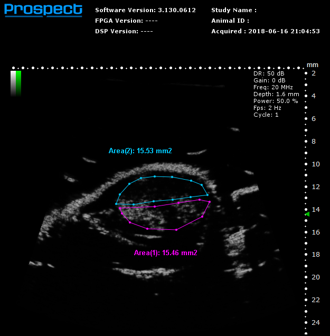

Mouse subcutaneous tumor – Non-linear contrast agent imaging Time vs. Intensity plots for drawn regions of interest
Shear Eave Elastography
Shear wave elastography is a technique used to study and quantify the mechanical and elastic properties of various tissues including liver, breast, tendons, muscles, etc. An acoustic radiation force is generated by a secondary, non-imaging, element mounted on the side of the imaging probe. The software is used to program the pulse sequence to generate the shear wave; the wave will propagate faster through stiffer tissues, as well as along the axis of various musculoskeletal structures. The analysis software generates a colored elastogram which is overlaid upon a B-mode image. Tissues with focal or diffuse lesions may be identified using this technique.
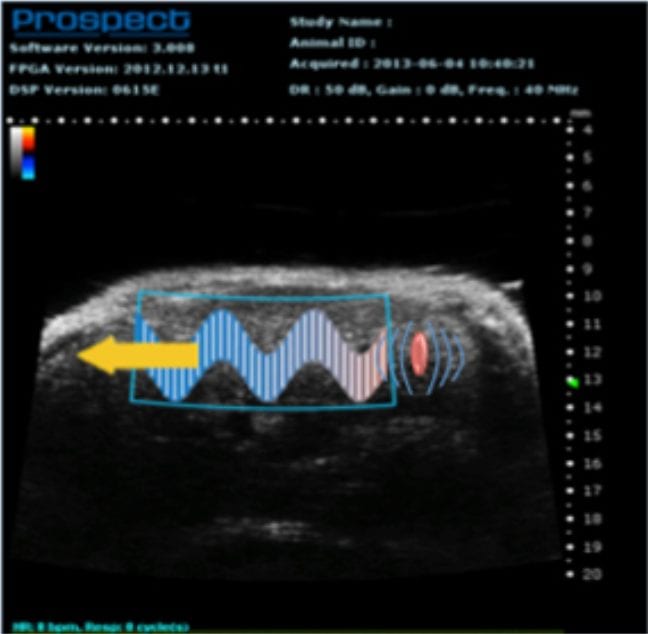
Propagation of Shear Wave through mouse liver
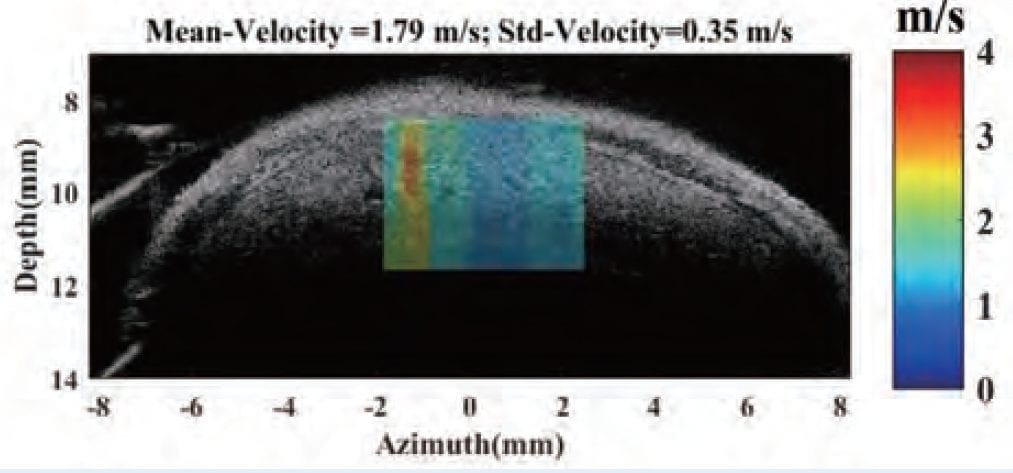
Shear Wave Elastogram showing focal lesion in mouse liver
Models & Specifications
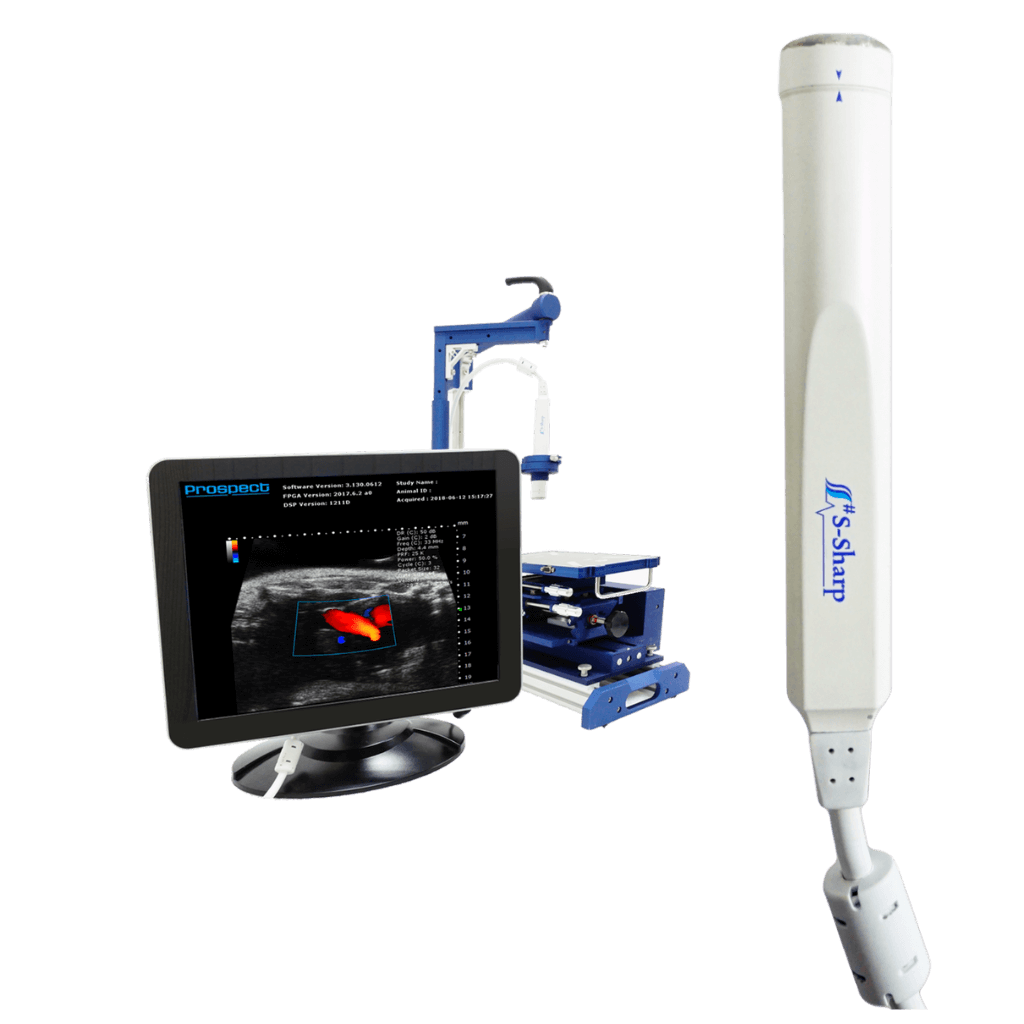
Available Probes
-
PB506e – Center Frequency 50MHz (30-60MHz)
-
PB406e – Center Frequency 40MHz (20-50MHz)
-
PB207e – Center Frequency 20MHz (10-30MHz)
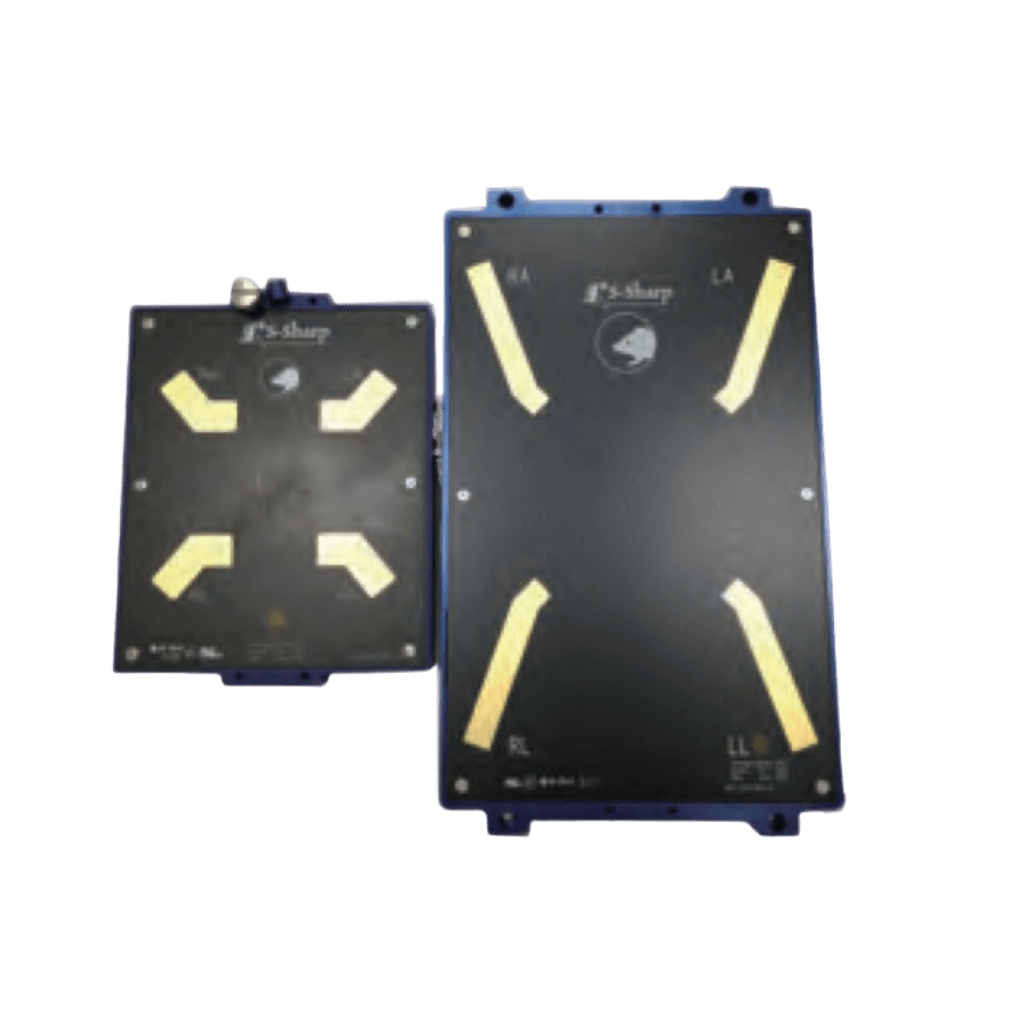
Available Platforms
-
Mouse Platform 17.2 x 14.2cm
-
Rat Platform 28.3 x 18.2cm
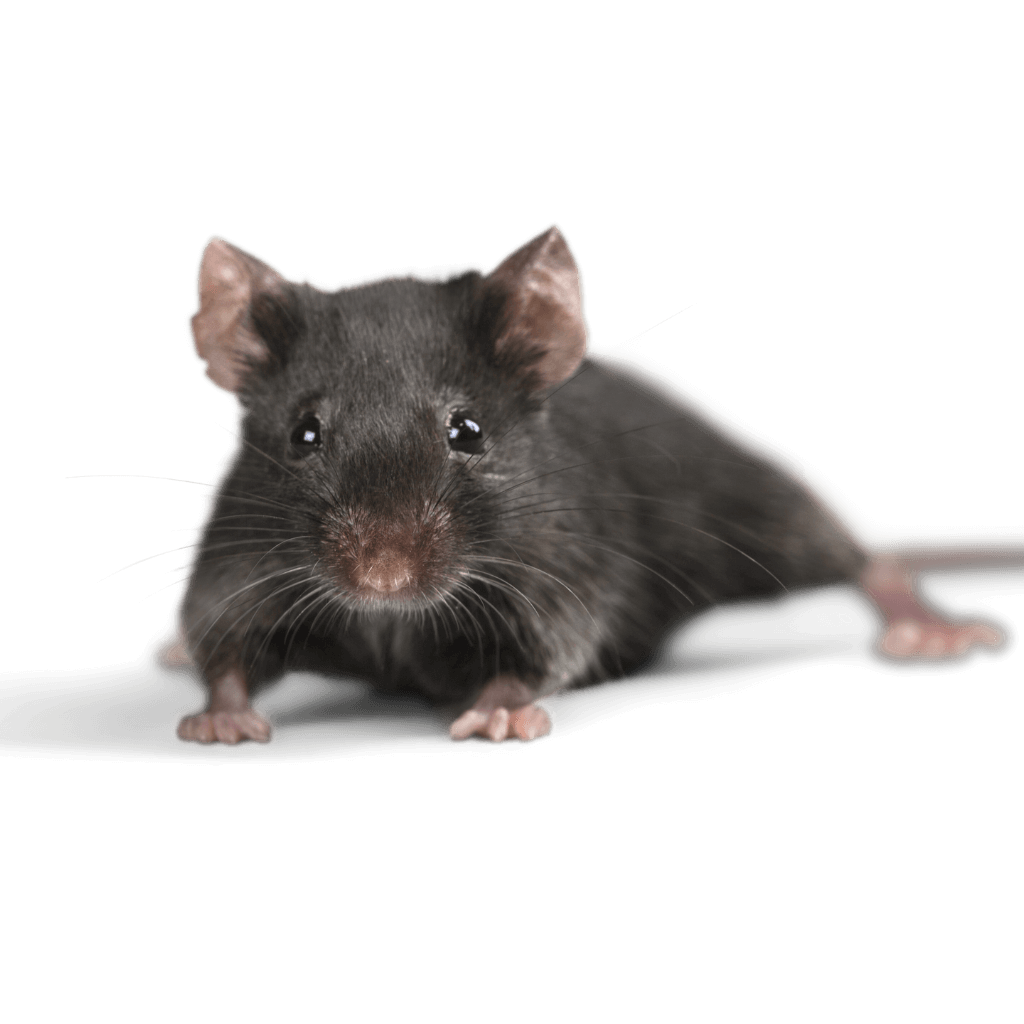
Standard - Advanced & Optional
-
B-Mode
-
M-Mode
-
Pulsed Wave / Tissue / Color / Power Doppler
-
Contrast Mode (Linear and Non-Linear/Harmonic
-
RAW data available for all modes
Accesories & add-ons
3D Motor and Acquisition/Analysis Software
The 3D motor connects to the imaging platform to precisely move the animal bed with imaging subject under the probe. The acquisition software allows the user to select the distance the motor will travel and the step size. The acquired imaging slices are then reconstructed into a 3D image. The visualization and analysis software allows the user to move through the acquired image, view it as a 3D surface, and make volume measurements.
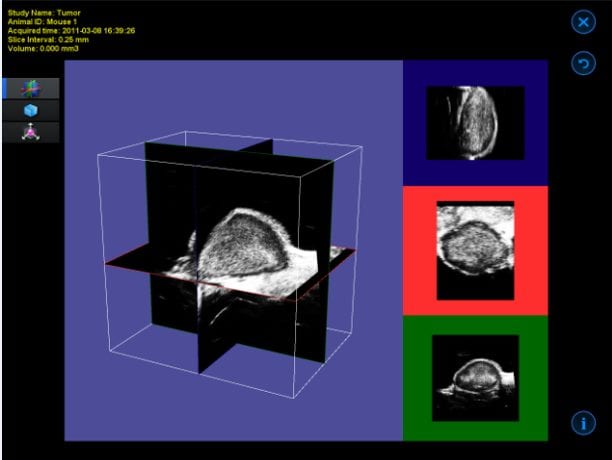
Mammary Fat Pad Tumor in Mouse – 3D Image
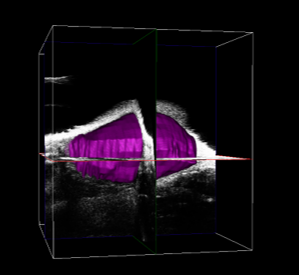
Mammary Fat Pad Tumor in Mouse – 3D Volume = 263mm3
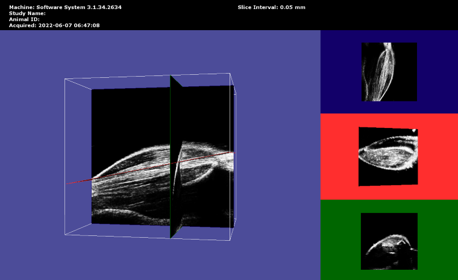
Mouse Hind Limb Muscle – 3D Image
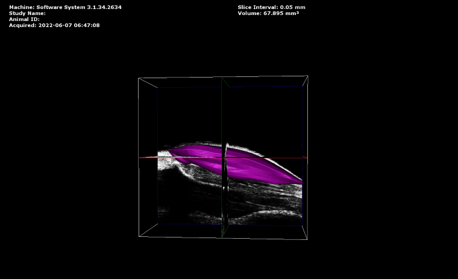
Mouse Hind Limb Muscle – 3D Volume = 97.6mm3
Image-guided Needle Injection Mount
Image guided needle injection is used to accurately target an injection site, whether it be the myocardium, abdominal organ, vascular target, or structure within the developing embryo. The injection mount is attached to the probe to help ensure the needle remains in alignment with the imaging plane. The trajectory of the needle can be adjusted and may be viewed using the image guide overlay. The needle is advanced manually into position while observing its position on a 2D B-mode image. The accessory may be used with either a standard syringe and needle or pulled glass capillary auto-injector.
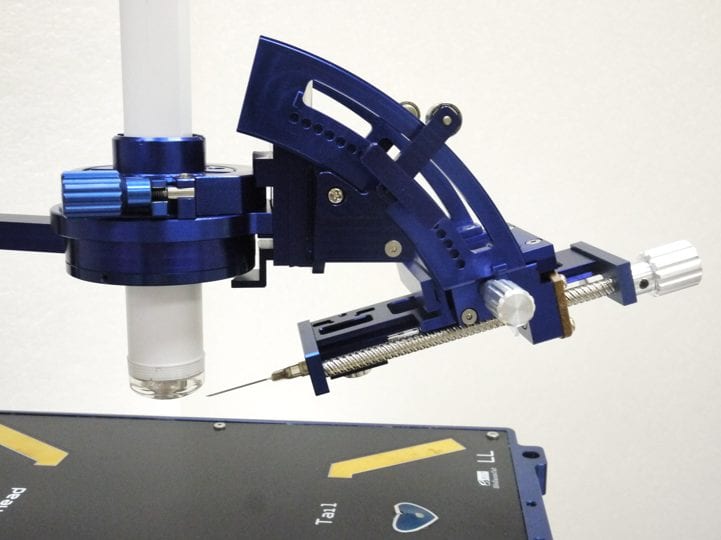
Injection Mount with Steel Needle and Syringe
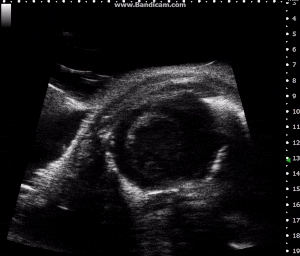
Image Guided Injection, with Steel Needle, into Mouse Myocardium

Image Guided Injection, with Pulled Glass Capillary Needle, into Externalized Mouse Embryo
Integrated Shear Wave Elastography Probe and Analysis Software
Shear wave elastography is a technique used to study and quantify the mechanical and elastic properties of various superficial tissues including liver, breast, tendons, muscles, etc. An acoustic radiation force is generated by a secondary, non-imaging, element mounted on the side of the imaging probe. The software is used to program the pulse sequence to generate the shear wave; the wave will propagate faster through stiffer tissues, as well as along the axis of various musculoskeletal structures. The analysis software generates a colored elastogram which is overlaid upon a B-mode image. Tissues with focal or diffuse lesions may be identified using this technique.

Propagation of Shear Wave through mouse liver

Image Guided Injection, with Steel Needle, into Mouse Myocardium
Prospect T1 Imaging Gallery
Applications
Cardiovascular Biology
The Prospect T1 is routinely used for cardiovascular imaging of a variety of small animal models, including mice and rats.
Real-time images are provided of the heart and a wide variety of blood vessels.
The system can be used to assess both systolic and diastolic function in the heart; as well to image and assess flow through any number of blood vessels, including the aorta, pulmonary, carotid, renal, splenic, and femoral arteries etc. Veins, including the vena cava and portal veins may also be assessed.
Imaging may be performed in utero, as early as day 1 after delivery, all the way through adulthood.
Cardiovascular function may be of interest as disease progresses, perhaps induced by surgical intervention, transgenic mutation, or systemic treatment with a therapy or toxic compound. Ultrasound imaging is non-invasive, so the same measurements may be taken repeatedly over the course of a longitudinal study.

Mouse Left Ventricle in Long Axis in B-Mode
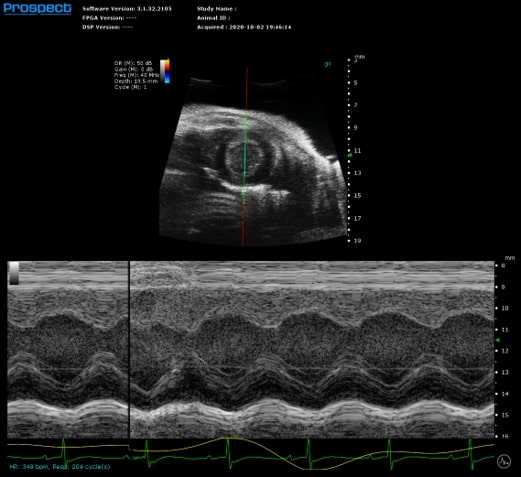
Mouse Left Ventricle in Short Axis in M-Mode with Measurements to Calculate Systolic Function

Mouse Mitral Valve Inflow in PW Doppler with Measurements to Calculate Diastolic Function
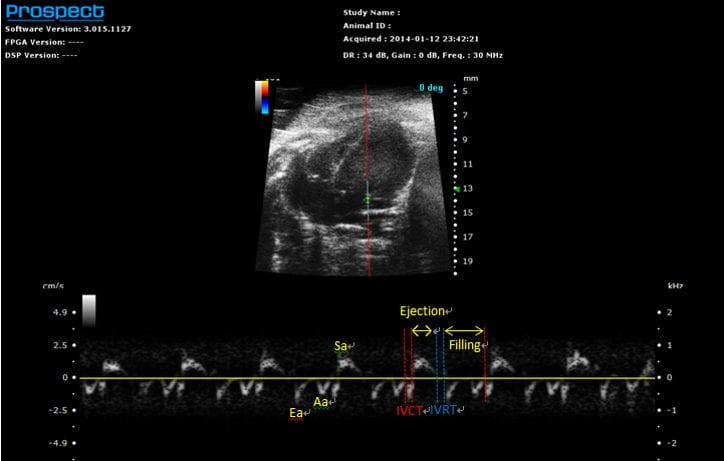
Mouse Mitral Annulus in Tissue Doppler with Measurements to Assess Diastolic Function
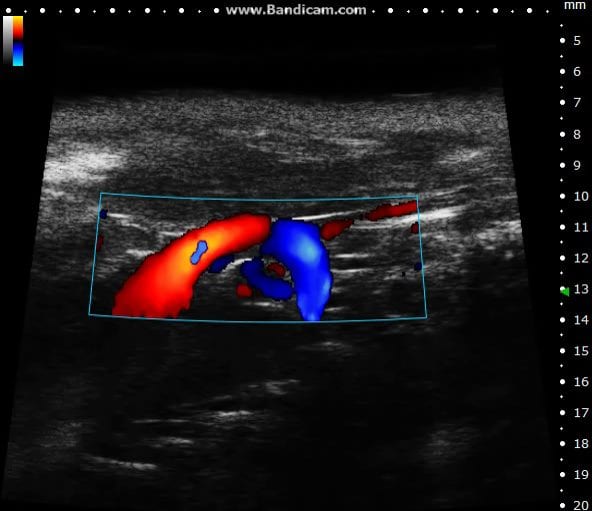
Caption – Mouse Aortic Arch in Color Doppler
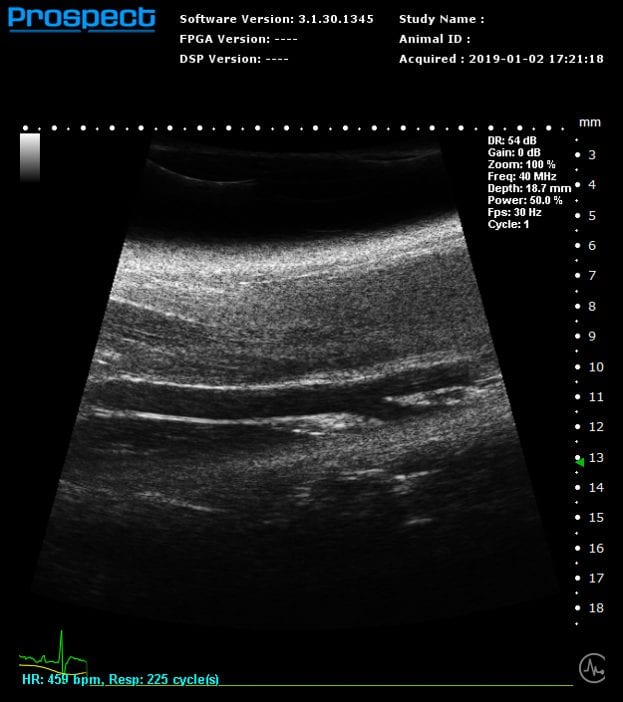
Mouse Carotid Artery in B-Mode
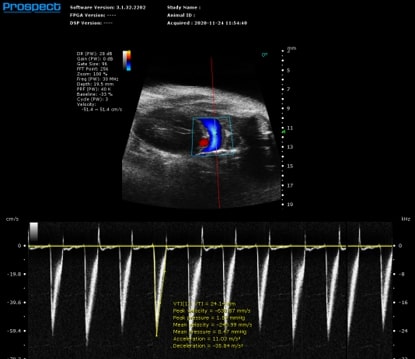
Mouse Pulmonary Artery in PW Doppler to Assess RV Outflow
Cancer Biology
The Prospect T1 is routinely used in a wide variety of oncology research applications. The system may be used on xerograph, orthotopic, PDX, and transgenic tumor models in a wide variety of animal models.
The system can be used to detect the presence of tumors or metastases in a wide variety of tissues, except for lungs, brain (due to the skull), and bones. Tumor volumes may be tracked over time, surrounding organs and structures can be imaged as well – such as the spleen or lymph nodes.
Blood flow may be assessed using Doppler techniques or using microbubble contrast agents, which may also be used to assess the molecular expression of specific biomarkers.
Image guided injections can be used to inject cells into a specific anatomical target, or to perform a biopsy or aspiration, reducing the need for invasive surgery.
Shear wave elastography can be used to assess mechanical changes within superficial organs, like the liver, or within the tumor itself.
All techniques can be used to observe the progression of a lesion over time, or the regression or alternative effects of therapeutic intervention. Ultrasound imaging is non-invasive, so the same measurements may be taken repeatedly over the course of a longitudinal study.
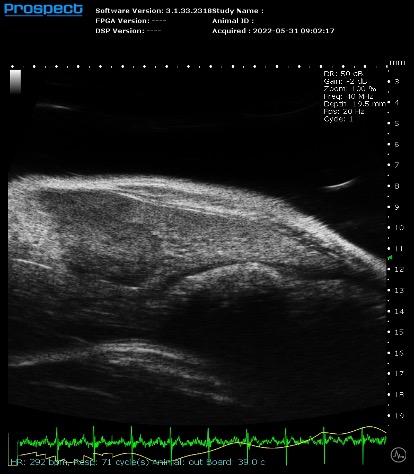
Mouse Live Tumor in B-Mode, Tumor Cells Orthotopically Injected
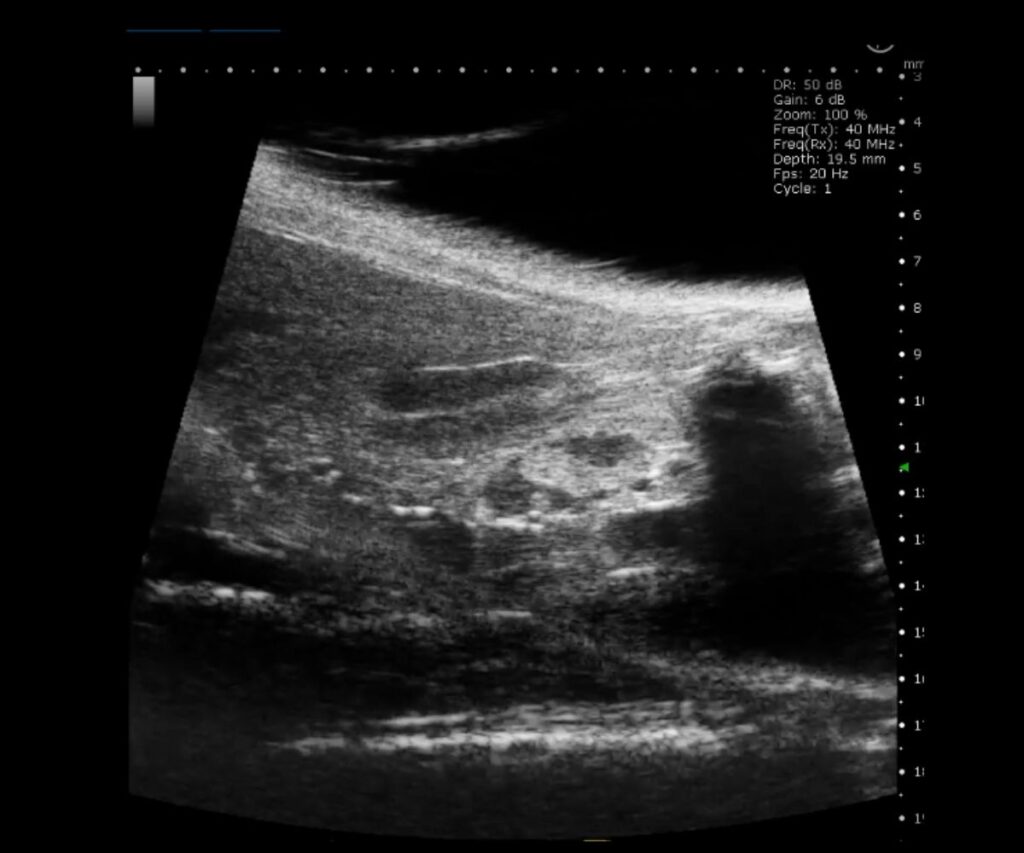
Mouse Pancreatic Tumor in B-Mode, Transgenic KPC Model

Mouse Mammary Fat Pad Tumor in 3D B-Mode, Orthotopically Injected Cells
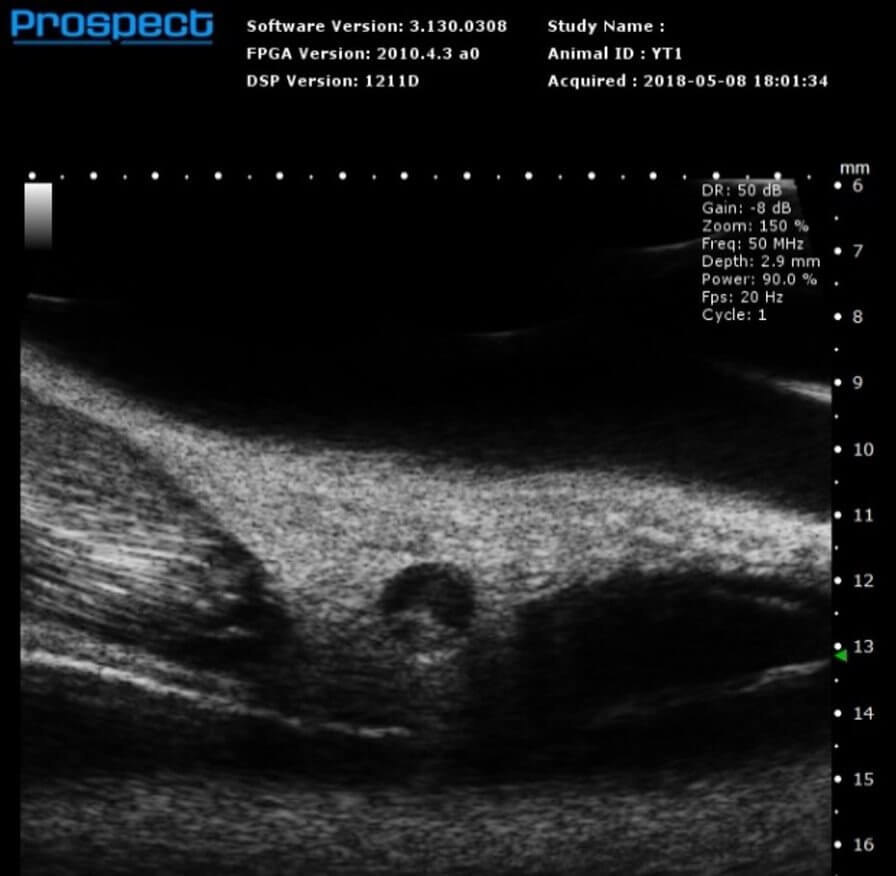
Mouse Inguinal Lymph Node in B-Mode
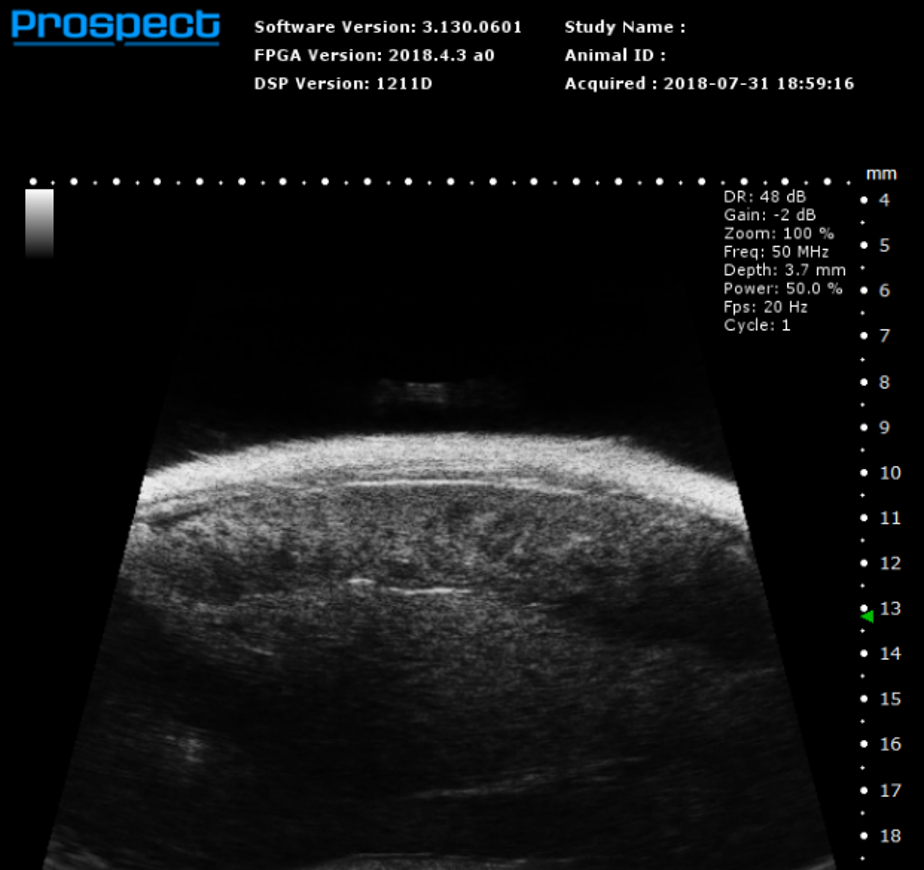
Mouse Spleen in B-Mode

Mouse subcutaneous tumor – Non-linear contrast agent imaging with regions of interest drawn

Mouse subcutaneous tumor – Non-linear contrast agent imaging Time vs. Intensity plots for drawn regions of interest
Abdominal & Anatomical Imaging
The Prospect T1 can be used to assess a variety of abdominal organs and tissues, along with many other anatomical structures within the urogenital tract, and musculoskeletal areas.
Organ size and location may be assessed both in 2D and 3D, while blood vessels may also be imaged, and flow assessed. Ultrasound may also be used to image structures outside of the abdomen such as the thymus, salivary glands, muscles, etc.
Image guided injection or biopsy may also be performed on any organ or tissue of interest, and shear wave elastography may also be used on a variety of superficial structures. Microbubble contrast agents may also be used to assess perfusion or expression of specific biomarkers in these areas.
All techniques can be used to observe the progression of a lesion over time, or the regression or alternative effects of therapeutic intervention. Ultrasound imaging is non-invasive, so the same measurements may be taken repeatedly over the course of a longitudinal study.
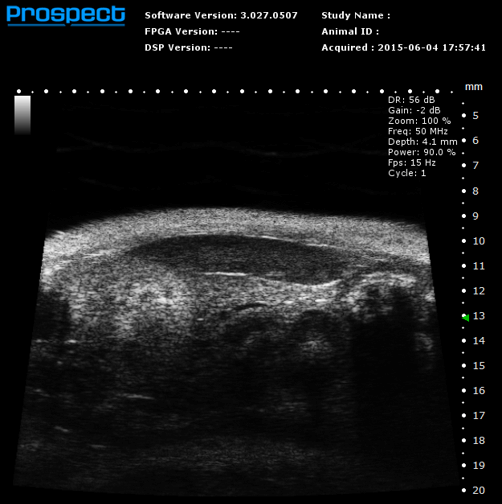
Mouse Abdominal Organs in B-Mode

Mouse Supra-Renal Abdominal Aorta Aneurysm in B-Mode

Mouse Hind Limb Muscle in 3D B-Mode
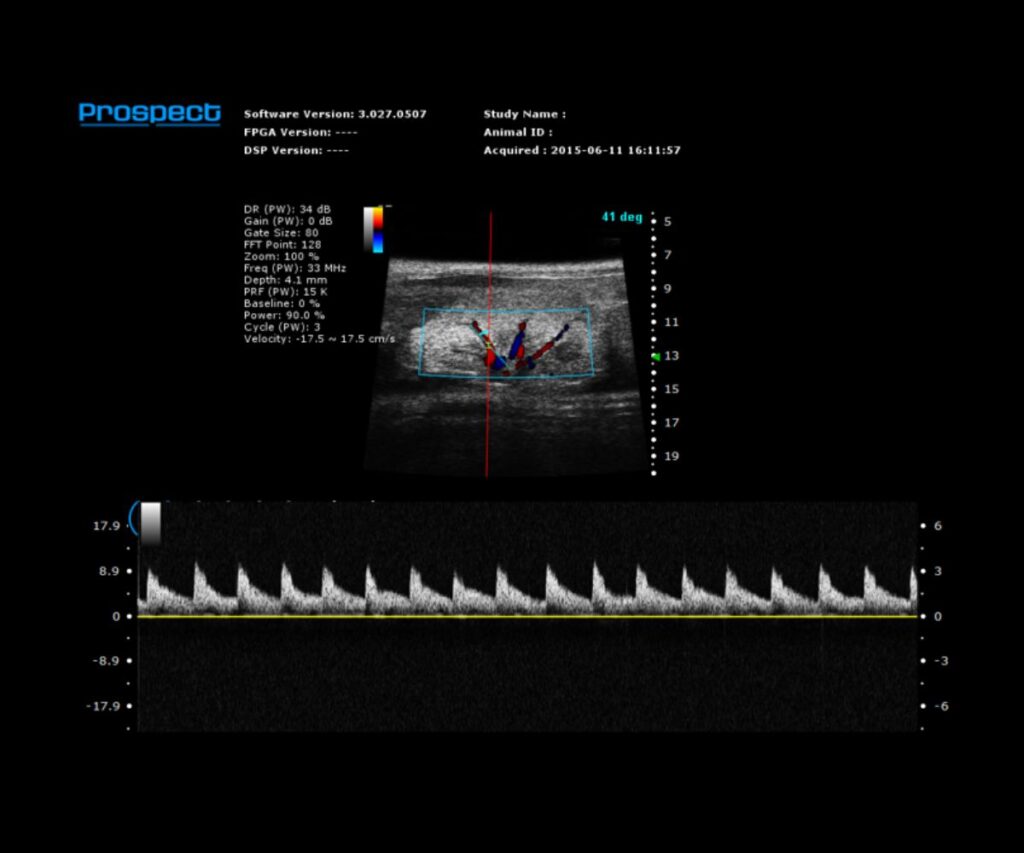
Mouse Renal Vasculature in PW Mode

Propagation of Shear Wave through mouse liver

Shear Wave Elastogram showing focal lesion in mouse liver
Developmental Biology
The Prospect T1 can be used to confirm, count, and stage pregnancy, assess embryonic development, visualize the first signs of cardiac contraction, and monitor embryos for viability or resorption.
All available imaging modes can be used on the developing embryos, including M-Mode, Color Doppler, and PW Doppler to assess cardiac function.
Image guided injections may be performed on externalized embryos. Once injections are complete, the uterine horns are replaced in the dame, and are delivered normally with the effects of the injection taking effect.
All techniques can be used to observe the progression of a lesion over time, or the regression or alternative effects of therapeutic intervention. Ultrasound imaging is non-invasive, so the same measurements may be taken repeatedly over the course of a longitudinal study.
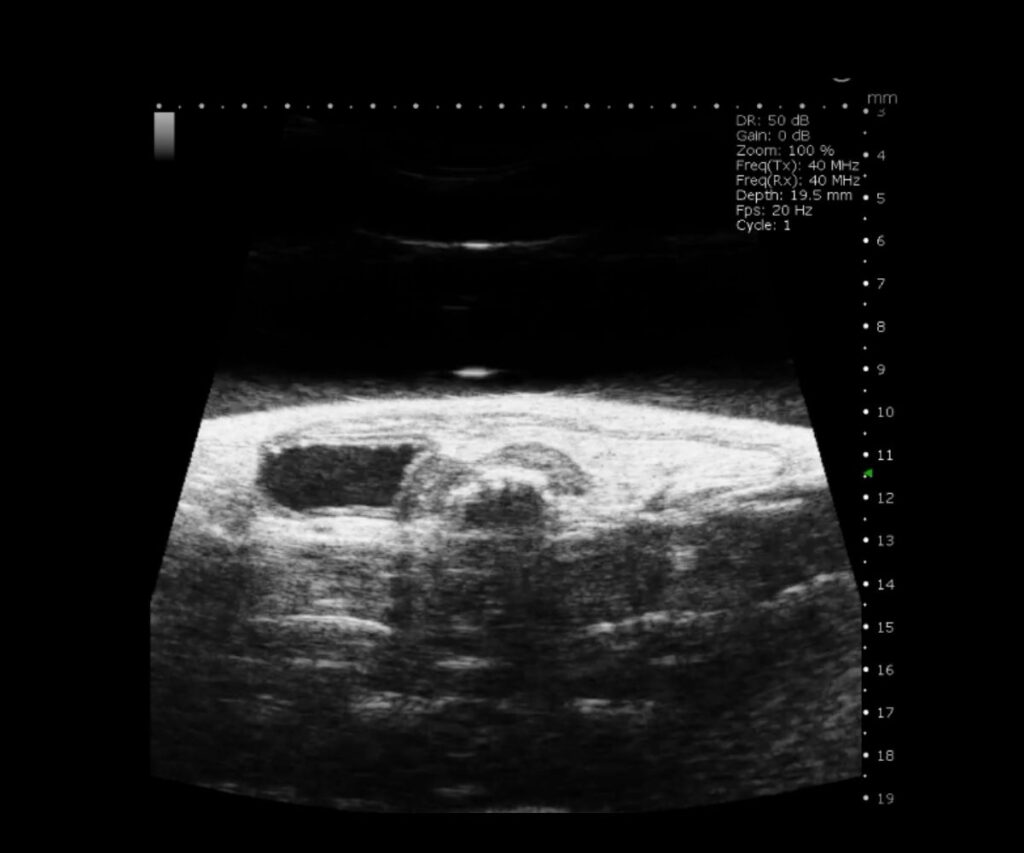
Mouse Uterine Horn in B-Mode
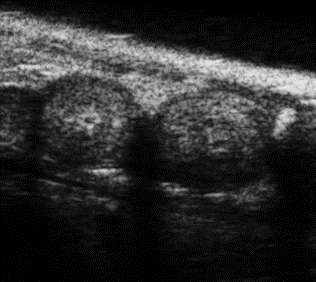
Mouse E7.5 Embryos in B-Mode
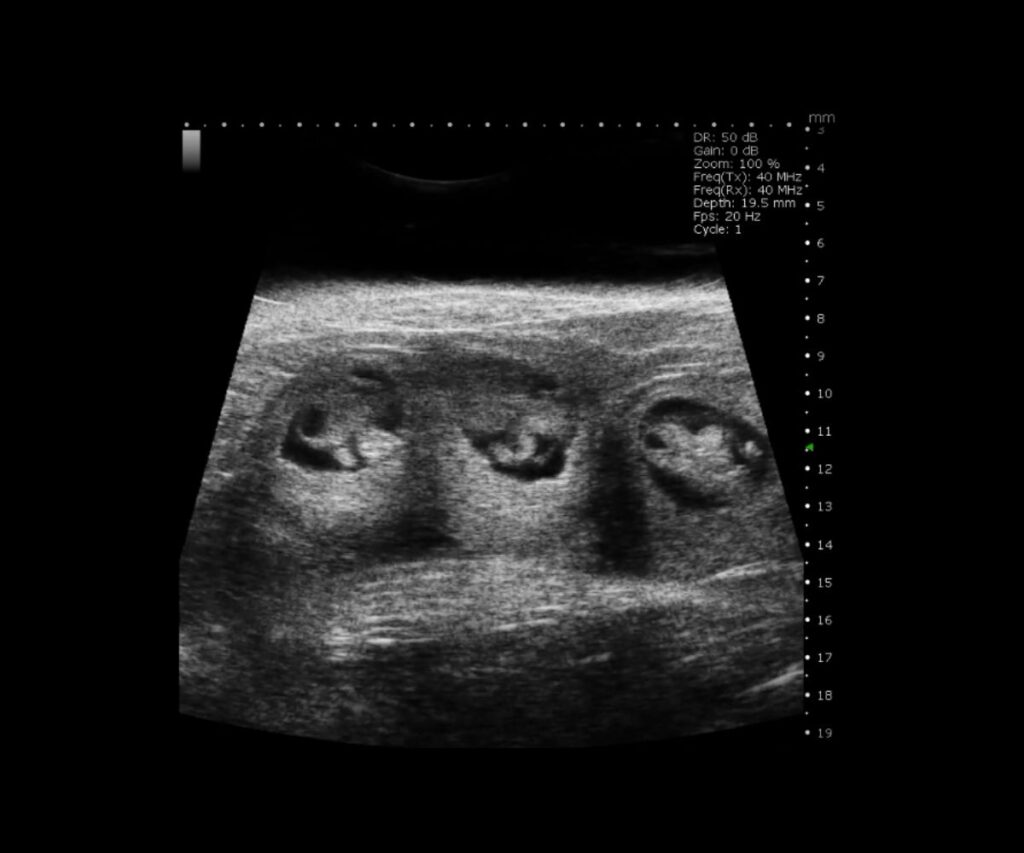
Mouse E10 Embryos in B-Mode
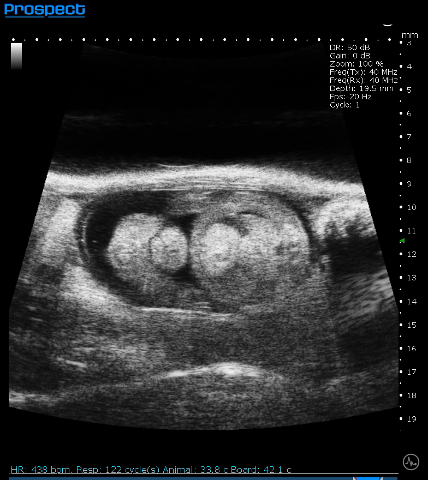
Mouse E15 Embryo in B-Mode
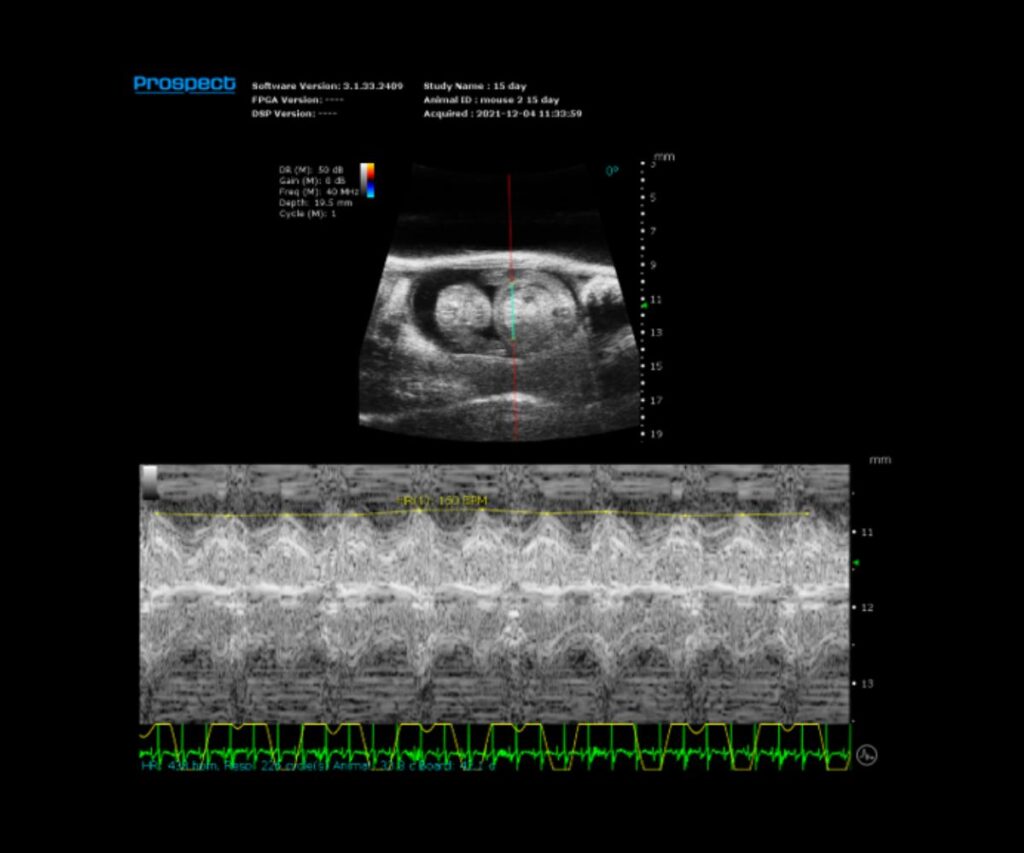
Mouse E15 Embryo in M-Mode with Heart Rate Measured

Mouse E15.5 Externalized Embryo with Image Guided Injection
Ophthalmology
The Prospect T1 can be used to visualize both the anterior and posterior structures of the eye from a variety of species, not limited to small animals. Three-dimensional imaging may also be performed on the eye. Doppler imaging modes can be used to assess flow in larger blood vessels, like the retinal artery, while microbubble contrast agents can be used to assess perfusion in the eye.
If any type of injection or biopsy is needed, the system can also be used to perform image guided injections.
All techniques can be used to observe the progression of a lesion over time, or the regression or alternative effects of therapeutic intervention. Ultrasound imaging is non-invasive, so the same measurements may be taken repeatedly over the course of a longitudinal study.
Image guided injections may be performed on externalized embryos. Once injections are complete, the uterine horns are replaced in the dame, and are delivered normally with the effects of the injection taking effect.
All techniques can be used to observe the progression of a lesion over time, or the regression or alternative effects of therapeutic intervention. Ultrasound imaging is non-invasive, so the same measurements may be taken repeatedly over the course of a longitudinal study.
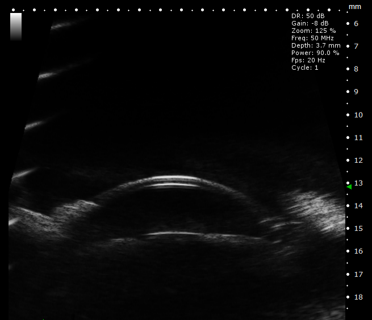
Rabbit Anterior Structure of Eye in B-Mode
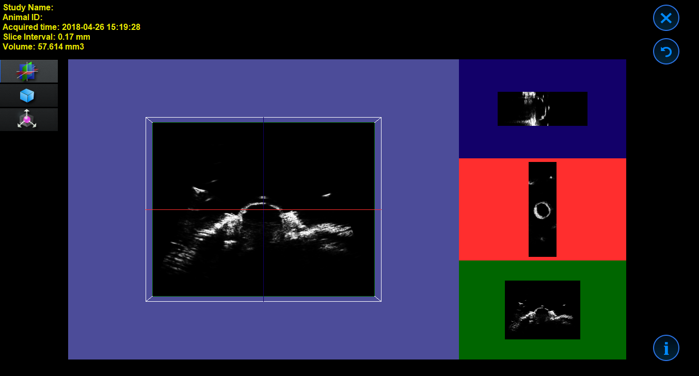
Mouse Eye in 3D B-Mode
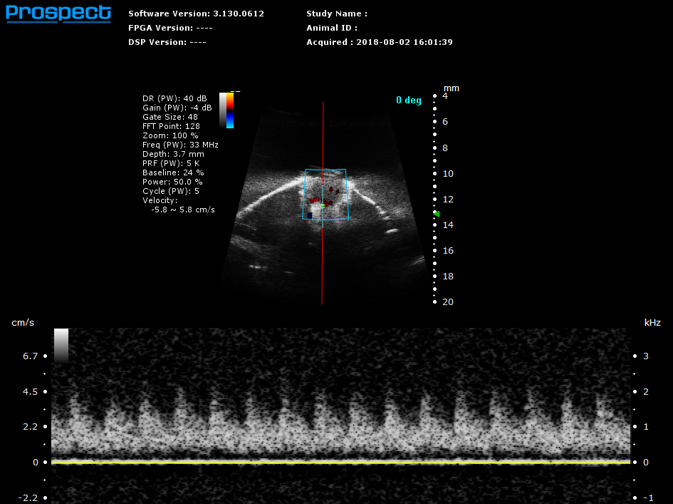
Mouse Retinal Artery in PW Doppler
Other Species
The Prospect T1 is not limited to use on conventional small animal models such as mice and rats. It can be used on a wide variety of other species including Zebrafish, Chick Embryos, other amphibious species, bats, hamsters, etc. As long as there is a liquid interface between the probe and the tissue, and the sound waves are able to penetrate, then an image should be possible.
Where appropriate all available imaging modes can be used, along with the 3D, and image guided injection options.
All techniques can be used to observe the progression of a lesion over time, or the regression or alternative effects of therapeutic intervention. Ultrasound imaging is non-invasive, so the same measurements may be taken repeatedly over the course of a longitudinal study.
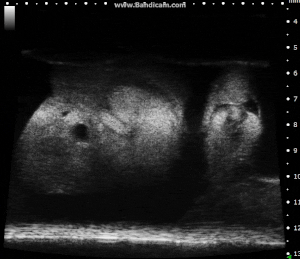
Chick Embryo Day 7 in B-Mode
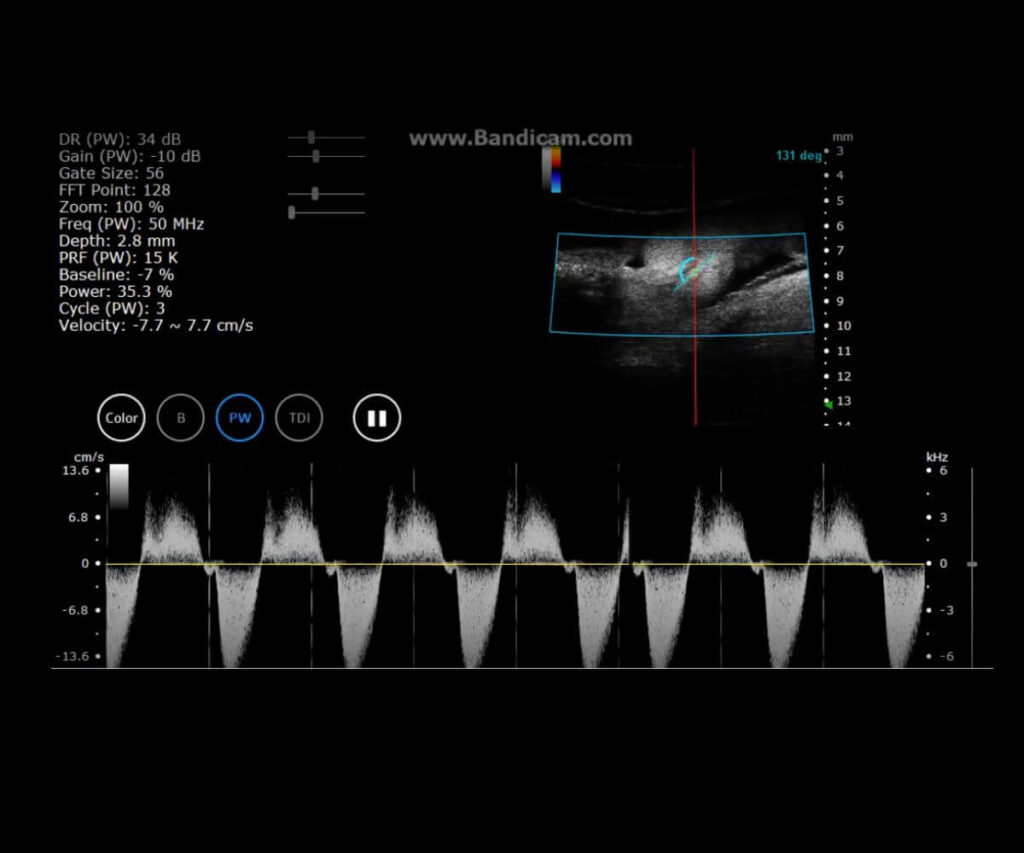
Chick Embryo Day 7 in PW Mode
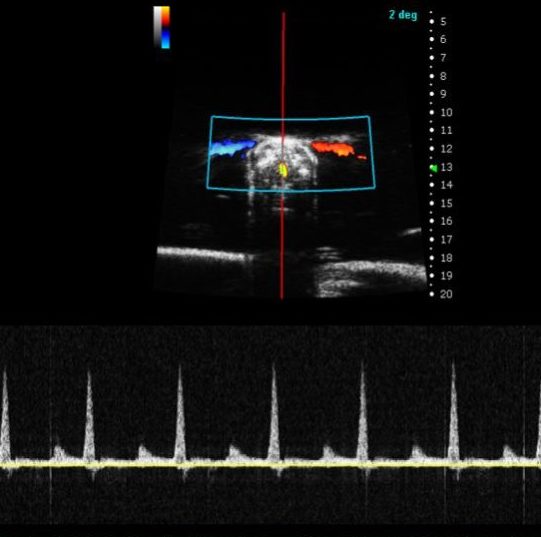
Zebrafish Heart in PW Mode
Publications & Articles
Read more about how our high-frequency ultrasound system has leverage the research work of many scientists around the globe.
Science Corner: Innovations in Radiolabelling Techniques
Innovations in Radiolabelling Techniques and Radioimmunotherapy Enhanced by Ultrasound Imaging Dr. Jason Holland’s
Allogeneic Expanded Human Peripheral NK Cells Control Prostate Cancer Growth in a Preclinical Mouse Model of Castration-Resistant Prostate Cancer
System Used:Prospect T1 Fangming Wang, Xuejiao Dong, Jing Wang, Feiya Yang, Donghua Liu,
(April 5, 2023) Webinar: Prodigy Open-Platform Research Ultrasound System Overview
(April 5, 2023) Webinar: Prodigy Open-Platform Research Ultrasound System Overview Overview:In this webinar,
Ursolic acid prevents doxorubicin‐induced cardiac toxicity
Ursolic acid prevents doxorubicin‐induced cardiac toxicity in mice through eNOS activation and inhibition
The Mouse Abdominal Imaging Guide
Mouse Abdominal Imaging Guide: Imaging the Liver, Hepatic Vessels, Portal Veins and Gallbladder
Applications in Developmental Biology
How the Prospect T1 high-frequency ultrasound system can be used in preclinical developmental
